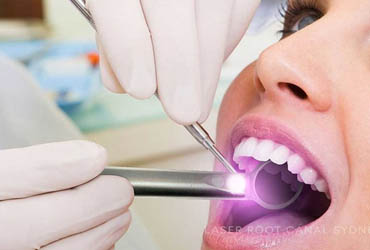New laser technology promises to change the way you experience traditional root canal therapy. After all, we now have air abrasion to fix cavities, so why not incorporate technology to improve the root canal procedure for busy or dental anxiety patients? Laser root canal therapy uses a parallel beam of intense light to clean out root canals. Laser therapy “melts” away debris consisting of bacteria and infection, known as the “smear layer” of the root, and cleans the root more thoroughly than traditional treatments. With less time and pain than a conventional root canal, laser dentistry can remove your infection so that you can get on with your life.
What Is A Laser Root Canal?
The invention of the Waterlase® Dental Laser from Biolase Technologies has changed the way some dentists perform root canals. Waterlase uses a laser and high-pressure water system to remove dead tissue and infection from the root’s canal. The only root canal laser approved by the FDA, the Waterlase system produces enough heat and pressure to remove debris without using drills or hand files, cutting down the time spent in the dental chair.
The Waterlase laser cleans the root more thoroughly than conventional root canal techniques. Microorganisms can hide in the dentinal tubules, or tiny holes, of the dentin surrounding the root. With conventional root canals, the cleaning process doesn’t always reach all of the tubules, leaving behind some of the bacteria well after the root canal is filled and sealed.
The laser penetrates deep into the porous tubules, removing bacteria without damaging the surrounding tissue. While traditional root canal instruments only clean out the tooth’s root, the laser actually sterilizes it, increasing your chances of a successful procedure.
What Are The Benefits of Laser Root Canal Therapy?
Laser technology also reduces possible side effects from the root canal procedure. There’s no need to worry about files breaking off or getting stuck in the canal. The Waterlase laser also limits the amount of bleeding during dental treatment, and can be used with minimal or no local anesthesia. Post-operative problems of traditional root canals are practically eliminated — the laser reduces the amount of inflammation, swelling and discomfort often felt as the anesthesia wears off. Patients may not even need pain medication often prescribed following dental surgery.
The Wasterlase laser is perfect for reaching areas that metal instruments don’t. Some dentists are combining both the laser and traditional hand pieces for optimal effects. Remember, your dentist’s goal is to save your tooth and get you out of pain, so regardless of what type of procedure you choose, root canal therapy is an important treatment to preserve your dental health.

